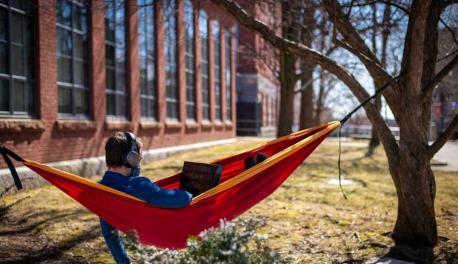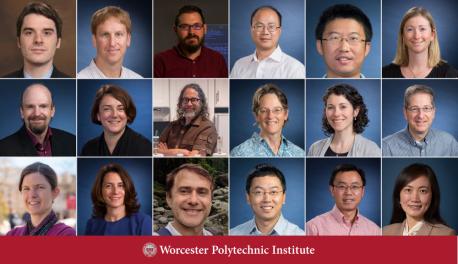I have a long-standing interest in applying computer science and mathematics to solve biological problems. I am currently the Associate Director of WPI’s Program in Bioinformatics and Computational Biology, and I am always looking for students with interests in this exciting interdisciplinary area. One of my goals in teaching biology is to help students to think more quantitatively about biological questions. A few years ago, my colleague Dr. Brian White of UMass Boston and I were awarded a grant from the NSF to develop a course, “Simulation in Biology”. In this class, students use an approach called agent-based modeling to simulate a biological system of their choice. The ‘agents’ can be molecules, cells, or organisms, and students program them to follow ‘rules’ that are drawn from what is known or hypothesized about how the agents actually behave. In constructing their simulation, students in the class develop a deeper understanding of both their biological system of interest, and of computer science.
I became so interested in this approach that I now focus my research in this area as well. I am currently collaborating with Dr. Rob Gegear, an ecologist who studies pollinator decline. Drastic declines in many pollinators have been observed in recent years, for reasons that are not well understood. Pollinators are important both for agricultural production, and also for maintenance of ecological food webs, as they are keystone species. Our students have developed “SimBee”, a model of virtual bumblebees in a floral environment, using the Netlogo platform. By incorporating what is known about bumblebee behavior and ecology into the model, we can ask many questions using the model that are difficult to address using field studies. We are also involved in funded research in collaboration with Dr. Alex Wyglinski (Electrical and Computer Engineering). In this research, we apply our knowledge of bumblebee foraging strategies to the problem of autonomous vehicle communication. It turns out that a bumblebee searching to find the best floral resources in a changing environment has many similarities to a vehicle searching for the best available communication channel. We also plan to use mathematical models derived from engineering concepts to experiment with various ways of representing memory in our SimBee model.
Dr. Gegear recently initiated ‘The Beecology Project’, a citizen science project which aims to gather critically needed ecological information on bumblebee pollinators and the flowers they pollinate. We have joined forces with two additional WPI colleagues, Dr. Carolina Ruiz (Computer Science) and Ms. Shari Weaver (STEM Education Center); the team recently received a $1.2M NSF Award to utilize The Beecology Project to motivate the integration of computer science and biology curriculum for high school students. Our team of students and faculty has developed smartphone and web apps, a database, simulations, and visualization tools to allow collection and analysis of ecological data that will help to determine the cause of wild pollinator decline. The curriculum we are developing in collaboration with high school teachers and students will allow students not only to use these data and tools, but to learn how to design and create their own digital tools to solve complex biological problems.
I have a long-standing interest in applying computer science and mathematics to solve biological problems. I am currently the Associate Director of WPI’s Program in Bioinformatics and Computational Biology, and I am always looking for students with interests in this exciting interdisciplinary area. One of my goals in teaching biology is to help students to think more quantitatively about biological questions. A few years ago, my colleague Dr. Brian White of UMass Boston and I were awarded a grant from the NSF to develop a course, “Simulation in Biology”. In this class, students use an approach called agent-based modeling to simulate a biological system of their choice. The ‘agents’ can be molecules, cells, or organisms, and students program them to follow ‘rules’ that are drawn from what is known or hypothesized about how the agents actually behave. In constructing their simulation, students in the class develop a deeper understanding of both their biological system of interest, and of computer science.
I became so interested in this approach that I now focus my research in this area as well. I am currently collaborating with Dr. Rob Gegear, an ecologist who studies pollinator decline. Drastic declines in many pollinators have been observed in recent years, for reasons that are not well understood. Pollinators are important both for agricultural production, and also for maintenance of ecological food webs, as they are keystone species. Our students have developed “SimBee”, a model of virtual bumblebees in a floral environment, using the Netlogo platform. By incorporating what is known about bumblebee behavior and ecology into the model, we can ask many questions using the model that are difficult to address using field studies. We are also involved in funded research in collaboration with Dr. Alex Wyglinski (Electrical and Computer Engineering). In this research, we apply our knowledge of bumblebee foraging strategies to the problem of autonomous vehicle communication. It turns out that a bumblebee searching to find the best floral resources in a changing environment has many similarities to a vehicle searching for the best available communication channel. We also plan to use mathematical models derived from engineering concepts to experiment with various ways of representing memory in our SimBee model.
Dr. Gegear recently initiated ‘The Beecology Project’, a citizen science project which aims to gather critically needed ecological information on bumblebee pollinators and the flowers they pollinate. We have joined forces with two additional WPI colleagues, Dr. Carolina Ruiz (Computer Science) and Ms. Shari Weaver (STEM Education Center); the team recently received a $1.2M NSF Award to utilize The Beecology Project to motivate the integration of computer science and biology curriculum for high school students. Our team of students and faculty has developed smartphone and web apps, a database, simulations, and visualization tools to allow collection and analysis of ecological data that will help to determine the cause of wild pollinator decline. The curriculum we are developing in collaboration with high school teachers and students will allow students not only to use these data and tools, but to learn how to design and create their own digital tools to solve complex biological problems.
Scholarly Work
WPI
National Science Foundation
National Science Foundation
NIH AREA Award
National Science Foundation CAREER Award


